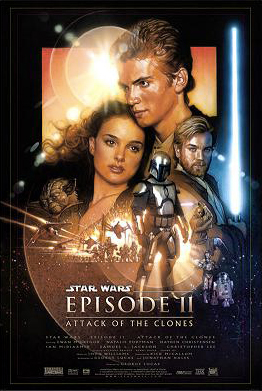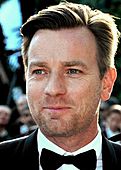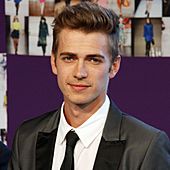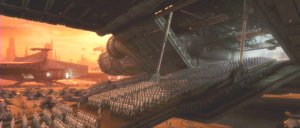Star Wars: Episode II – Attack of the Clones facts for kids
Quick facts for kids Star Wars: Episode II – Attack of the Clones |
|
|---|---|

Theatrical release poster by Drew Struzan
|
|
| Directed by | George Lucas |
| Produced by | Rick McCallum |
| Screenplay by |
|
| Story by | George Lucas |
| Starring | |
| Music by | John Williams |
| Cinematography | David Tattersall |
| Editing by | Ben Burtt |
| Studio | Lucasfilm Ltd. |
| Distributed by | 20th Century Fox |
| Release date(s) | May 12, 2002 (Tribeca) May 16, 2002 (United States) |
| Running time | 142 minutes |
| Country | United States |
| Language | English |
| Budget | $115 million |
| Money made | $653.8 million |
Star Wars: Episode II – Attack of the Clones is an exciting space opera movie from 2002. It was directed by George Lucas, who also helped write the story. This film is the fifth in the Star Wars series and the second part of the "Skywalker Saga" story. It continues the adventures from The Phantom Menace (1999).
The movie stars many famous actors like Ewan McGregor, Natalie Portman, Hayden Christensen, and Samuel L. Jackson. The story takes place ten years after the first movie. Many planets are leaving the Galactic Republic to join a new group called the Confederacy of Independent Systems. This group is led by a former Jedi Master, Count Dooku.
The galaxy is close to a big war. Obi-Wan Kenobi investigates a mystery after someone tries to harm Senator Padmé Amidala. This leads him to discover a secret clone army being made for the Republic. Meanwhile, Obi-Wan's student, Anakin Skywalker, is assigned to protect Padmé. They start to have special feelings for each other. Soon, they all see the start of a huge conflict: the Clone Wars.
The movie was made using new digital cameras, making it one of the first films shot entirely in high-definition digital. It was released in the United States on May 16, 2002. The film made a lot of money, earning $653.8 million worldwide. It was followed by Revenge of the Sith (2005), which finished the prequel story.
Contents
Movie Story: Attack of the Clones
A Galaxy in Trouble
Ten years after the battle on Naboo, the Galactic Republic faces a new danger. A movement led by former Jedi Master Count Dooku wants to break away. Senator Padmé Amidala goes to Coruscant to vote against creating an army for the Jedi. Soon after she arrives, someone tries to attack her.
Jedi Protection and a Secret Mission
Padmé is then protected by Jedi Master Obi-Wan Kenobi and his student, Anakin Skywalker. They stop another attack on Padmé. The attacker, Zam Wesell, is stopped, but a bounty hunter kills her before she can reveal who hired him. The Jedi Council tells Obi-Wan to find this bounty hunter. Anakin is sent to protect Padmé and take her to Naboo. Even though Jedi are not supposed to form close relationships, Anakin and Padmé start to fall in love.
Obi-Wan's Investigation
Obi-Wan's search leads him to Kamino, a water planet. There, he finds a huge clone army being made for the Republic. This army was ordered by a Jedi Master named Sifo-Dyas, who is now gone. The bounty hunter Jango Fett is the person whose DNA was used to create the clones. Obi-Wan realizes Jango is the bounty hunter he is looking for. After a short fight, Obi-Wan puts a tracker on Jango's ship, Slave I. He then follows Jango and his young clone son, Boba, to the planet Geonosis.
Anakin's Difficult Journey
Meanwhile, Anakin has troubling visions of his mother, Shmi, in pain. He returns to his home planet, Tatooine, with Padmé to find her. Watto tells him that he sold Shmi to a farmer named Cliegg Lars, who later married her. Cliegg explains that Tusken Raiders took Shmi a month ago and she is likely gone. Anakin finds her at the Tusken campsite, barely alive. After she passes away, a very angry Anakin attacks the entire tribe. He later tells Padmé what he did and promises to protect those he cares about.
The Separatist Plot and the Clone Wars Begin
On Geonosis, Obi-Wan discovers a meeting of Separatists led by Count Dooku. They are building a droid army with Trade Federation Viceroy Nute Gunray, who ordered the attacks on Padmé. Obi-Wan sends his findings to the Jedi Council but is captured. Dooku tells Obi-Wan that the Sith Lord Darth Sidious secretly controls a big part of the Galactic Senate. He asks Obi-Wan to join him to stop Sidious, but Obi-Wan refuses.
Back on Coruscant, Senate Representative Jar Jar Binks helps pass a vote to give Chancellor Palpatine special emergency powers. This allows the clone army to be officially approved.
Battle on Geonosis
Anakin and Padmé go to Geonosis to rescue Obi-Wan. Anakin loses his lightsaber in a droid factory before Jango captures them. In an arena, Dooku sentences the three to face dangerous creatures. Suddenly, a large group of clone troopers led by Yoda, Mace Windu, and other Jedi arrive. Windu defeats Jango during the battle. Obi-Wan and Anakin confront Dooku in a lightsaber duel. Dooku hurts Obi-Wan and cuts off Anakin's right arm. Yoda then steps in to defend them. To escape, Dooku uses the Force to try and harm Anakin and Obi-Wan.
Dooku escapes to Coruscant and gives plans for a powerful weapon to Sidious. The Jedi Council is worried by Dooku's claim that Sidious controls the Senate. As the Jedi realize the Clone Wars have begun, Anakin gets a robotic arm. He then secretly marries Padmé on Naboo.
Main Characters
- Ewan McGregor as Obi-Wan Kenobi: A wise Jedi Knight and Anakin's teacher. He investigates the attacks on Padmé and finds the secret clone army.
- Natalie Portman as Padmé Amidala: The former Queen of Naboo, now a Senator. She is the target of attacks and Anakin's love interest.
- Hayden Christensen as Anakin Skywalker: A powerful 19-year-old Jedi student. He is assigned to protect Padmé and falls in love with her. Many believe he is the "chosen one" who will bring balance to the Force. George Lucas looked at many actors before choosing Hayden Christensen for this important role.
- Ian McDiarmid as Palpatine / Darth Sidious: A Senator from Naboo who becomes the Supreme Chancellor. He secretly controls the Separatist movement as a powerful Sith Lord.
- Samuel L. Jackson as Mace Windu: A respected Jedi Master on the Jedi Council. He is a strong leader and fighter.
- Christopher Lee as Count Dooku / Darth Tyranus: A former Jedi Master and Obi-Wan's old teacher's teacher. He now leads the Separatist movement and is a new apprentice to Darth Sidious.
- Anthony Daniels as C-3PO: A polite robot built by Anakin when he was a child. He now serves the Lars family on Tatooine.
- Kenny Baker as R2-D2: Anakin's loyal little robot friend who often goes on missions with him and Obi-Wan.
- Frank Oz as Yoda: The very old and wise Grandmaster of the Jedi. He teaches young Jedi students.
Other important characters include:
- Pernilla August as Shmi Skywalker: Anakin's mother.
- Ahmed Best as Jar Jar Binks: A Gungan who is now a Senator.
- Silas Carson as Nute Gunray: The leader of the Trade Federation.
- Jimmy Smits as Bail Organa: A Senator from Alderaan.
- Temuera Morrison as Jango Fett: A skilled bounty hunter whose DNA is used to create the clone army.
- Daniel Logan as Boba Fett: Jango Fett's young clone son.
- Leeanna Walsman as Zam Wesell: A shapeshifting bounty hunter who tries to attack Padmé.
- Ronald Falk as Dexter Jettster: Obi-Wan's friend who helps him find information.
How the Movie Was Made
Writing the Story
After the first prequel movie, The Phantom Menace, George Lucas wasn't sure about writing the next one. But in March 2000, he finished a first version of the script for Episode II. He worked with Jonathan Hales, who had written for Lucas before. The final script was ready just a few days before filming began.
As a joke, the movie's secret working title was Jar Jar's Great Adventure. This was a funny nod to how some fans felt about the character Jar Jar Binks from the first movie.
Filming Locations and Technology
Filming took place from June to September 2000 at Fox Studios Australia in Sydney. They also filmed in real places like the desert in Tunisia, the beautiful Plaza de España in Seville, and lovely locations in Italy.
A cool fact is that Samuel L. Jackson, who plays Mace Windu, asked for his lightsaber to be purple. Usually, good guys have blue or green lightsabers, and bad guys have red ones. This made his lightsaber unique!
Attack of the Clones was one of the first big movies to be filmed completely with a digital camera. This was a big step for Hollywood, moving towards "digital filmmaking." George Lucas wanted to use these cameras for the first prequel, but they weren't ready in time.
Amazing Visual Effects
This movie used a lot of digital effects to create its amazing world. Instead of drawing storyboards, the team used "animatics." This meant they made rough computer-generated versions of scenes to see how they would look. This helped them plan the movie's action sequences.
The film also used "digital doubles." These are computer models that stand in for actors, just like real stunt doubles do. A big challenge was creating a completely CGI version of the character Yoda. The creators wanted the digital Yoda to look and move like the puppet version from the older Star Wars movies. They even talked to Frank Oz, who voiced and controlled the Yoda puppet, for advice. He said Yoda should look very old and a bit stiff.
Because of the fast-paced lightsaber fight between Count Dooku and Yoda, the actor Christopher Lee (who played Dooku) used a stunt double for the tricky parts. Lee's face was then added onto the double's body for those scenes.
The Music of Star Wars
The music for Attack of the Clones was created by the famous composer John Williams. He conducted the London Symphony Orchestra to bring the galaxy to life with sound. The soundtrack includes a hint of "The Imperial March" from The Empire Strikes Back, which is a famous theme for the bad guys. The soundtrack was released in April 2002.
Movie Themes and Connections
Real-World Inspirations
George Lucas has said that Palpatine's rise to power in the movie is similar to how some real-world leaders gained control. For example, it has been compared to Adolf Hitler in Nazi Germany and Napoleon Bonaparte. These leaders were given special powers during times of trouble, just like Palpatine.
The movie also shows how money and power can influence politics. The Trade Federation, Dooku, and Palpatine all represent greed and ambition. The Jedi, however, try to do what is right.
Linking to Other Star Wars Movies
The prequel movies often connect to the original Star Wars films. Lucas has said the movies are like a long poem that "rhymes." For example, the line "I have a bad feeling about this" is said in every Star Wars movie. Lightsaber duels often happen over deep pits.
Attack of the Clones has many connections to The Empire Strikes Back. Both are the middle movies in their trilogies. In both films, there's a big space battle in an asteroid field. Obi-Wan hides his ship by attaching it to an asteroid, similar to how Han Solo does it in The Empire Strikes Back. The clone troopers in this movie also show where the famous stormtroopers from the original trilogy came from.
Books and Comics
Two books based on the movie were released. One was a junior novel for younger readers. The other was a full novel written by R. A. Salvatore, which included some extra scenes. There was also a four-issue comic book series that adapted the movie's story.
What Happens Next
The story of Attack of the Clones continues in Revenge of the Sith, which came out on May 19, 2005. This movie shows how Anakin Skywalker finally becomes the evil Darth Vader. It also shows the end of the Jedi, with only Obi-Wan and Yoda surviving.
|
See also
 In Spanish: Star Wars: Episodio II - El ataque de los clones para niños
In Spanish: Star Wars: Episodio II - El ataque de los clones para niños






